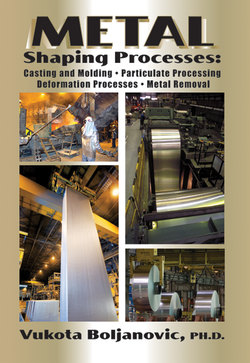Читать книгу Metal Shaping Processes - Vukota Boljanovic - Страница 7
На сайте Литреса книга снята с продажи.
ОглавлениеPREFACE
The study of manufacturing engineering is an important discipline in any industrial society, and within that discipline one of the more important subjects is manufacturing processes. This book is intended to treat one broad and challenging part of this subject—metal shaping processes. It is a comprehensive text written mainly for students in mechanical, industrial, and manufacturing engineering programs at both the associate and bachelor degree levels. The fundamentals of metal shaping processes and their relevant applications are presented step-by-step so that the reader can clearly assess the capabilities, limitations, and potentialities of these processes and their competitive aspects. The text, as well as the numerous formulas and illustrations in each chapter, clearly shows that shaping processes, as a part of manufacturing engineering, constitute a complex and interdisciplinary subject. The topics are organized and presented in such a manner that they motivate and challenge students to develop technically and economically viable solutions to a wide variety of questions and problems, including product design.
The field of mechanical engineering and manufacturing technology continues to advance rapidly, transcending disciplines and driving economic growth. This challenging field continues to incorporate new concepts at an increasing rate, making manufacturing a dynamic and exciting field of study. In preparing this book my most important goal was to provide a comprehensive state-of-the-art textbook on the most common metal shaping processes; an equally important aim was to motivate and challenge students to understand and later, perhaps, to work with this common manufacturing process.
The book is organized into four parts with thirteen chapters. The first part of the book covers casting, molding, and other processes in which the starting material is a heated liquid. The discussion is divided into three chapters: The fundamentals of metal casting processes, metal casting processes, and metal casting design and materials.
The second part of the book deals with basic particulate processing, these in which the starting materials are metal powders. The powder metallurgy of the various metals is discussed as one unit.
The third part discusses the most commonly used metal deformation processes, in which the starting materials are solid. This section is divided into five chapters: The fundamentals of metal forming, rolling, forging, extrusion and drawing, and sheet metal working.
The fourth part of the book discusses the most commonly used metal removal processes, those in which the starting materials are likewise solid. This part of the book is divided into four chapters: The fundamentals of metal machining, machining processes, abrasive machining processes, and nontraditional machining processes.
Although the book provides many calculations, illustrations, and tables, it should be evident that detailed analytical mathematical transformations are not included; however, the final formulas derived from them (which are necessary in practical applications) are included.
Measurements are given in both ISO and U.S. unit systems. At the end of each chapter, review questions are given that allow students to review chapter contents in a quick and enjoyable fashion.
By reading and studying this book, my hope is that students will be introduced to an academic subject that is as exciting, challenging, and as important as any other engineering and technology discipline; professionals will also find this book a very effective tool and reference.
The author owes much to many people. I am grateful to my son Sasha, who labored countless hours at converting AutoCAD drawings into a format compatible with commercial printing. In addition, I would like to acknowledge John F. Carleo, editorial director at Industrial Press, who worked with me during the manuscript preparation and persuaded me of the continuing interest of Industrial Press in publishing my fourth book. Finally, I wish to thank Em Turner Chitty for her help.
Vukota Boljanovic
Knoxville, Tennessee
